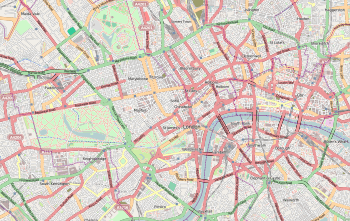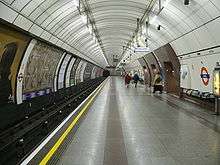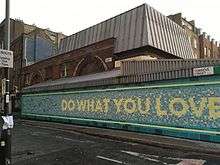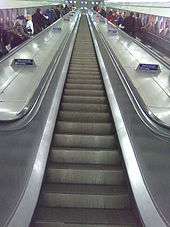Angel tube station
Angel is a London Underground station in the Angel area of the London Borough of Islington. It is on the Bank branch of the Northern line, between Old Street and King's Cross St. Pancras stations, in Travelcard Zone 1.[3] The station was originally built by the City & South London Railway (C&SLR) and opened on 17 November 1901. The station served as a terminus until the line was extended to Euston on 12 May 1907.
| Angel | |
|---|---|
Entrance on Islington High Street | |
 Angel Location of Angel in Central London | |
| Location | Angel |
| Local authority | London Borough of Islington |
| Managed by | London Underground |
| Number of platforms | 2 |
| Fare zone | 1 |
| London Underground annual entry and exit | |
| 2014 | |
| 2015 | |
| 2016 | |
| 2017 | |
| 2018 | |
| Key dates | |
| 17 November 1901 | Opened |
| Other information | |
| External links | |
| WGS84 | 51.532°N 0.106°W |
The station was rebuilt in 1992 to accommodate the large number of passengers using the station. As a result, it has an extra-wide southbound platform, surfaced over the original 'Island' platform which had accessed both North and Southbound trains from a central landing, and features the longest escalators on the Underground network,[4][5][6] and the fourth-longest escalators in Western Europe.[7][8][9] It is a candidate station on the proposed Crossrail 2 line from north Surrey and south-west London to south-east Hertfordshire.
Location
On Islington High Street, the station provides access to several nearby Off West End or Fringe theatre venues including the Old Red Lion Theatre, Sadler's Wells Theatre, the King's Head Theatre and the Almeida Theatre.[10] It is the nearest station to City University's main campus, Chapel Market,[10] and the antiques market and dealers of Camden Passage. Between Angel and Old Street is the disused City Road station.[11]
History
Angel station was originally built by the City & South London Railway (C&SLR), and opened on 17 November 1901[note 1] as the northern terminus of a new extension from Moorgate.[14][15] The station building was designed by Sydney Smith and was on the corner of City Road and Torrens Street.[16] On 12 May 1907, the C&SLR opened a further extension from Angel to Euston[14] and Angel became a through station.[15]
As with many of the C&SLR's stations, it was originally built with a single central island platform serving two tracks in a single tunnel[4] – an arrangement still seen at Clapham North and Clapham Common. Access to the platforms from street level was via three Euston Anderson electric lifts before the rebuilding of the station. When the C&SLR line was closed for tunnel reconstruction in the early 1920s to accommodate larger trains,[14] the station façade was reclad with tiling and the lifts were replaced by new ones from Otis.[16]


Station rebuilding
For years since its opening, the station regularly suffered from overcrowding and had a very narrow island platform (barely 12 feet (3.7 m) in width), which constituted a major safety issue and caused justified fear among passengers.[17] Consequently, the station was comprehensively rebuilt in the early 1990s.[11] A new section of tunnel was excavated for a new northbound platform, and the southbound platform was rebuilt to completely occupy the original 30-foot tunnel, leaving it wider than most deep-level platforms on the system.[note 2] The lifts and the ground-level building were closed and a new station entrance around the corner in Islington High Street was opened on 10 August 1992, along with the new northbound platform; the enlarged southbound platform opened on 17 September 1992.[11] Because of the distance between the new entrance and the platforms, and their depth, two flights of escalators were required, aligned approximately at a right angle.[5]
The station today


The station's ticket hall has a sculpture of an Angel by Kevin Boys.
Escalators
Angel is one of fourteen stations to have only escalator access to the platforms.[18] With a vertical rise of 90 feet (27 m) and a length of 200 feet (61 m), the escalators at Angel station are the longest on the Underground,[5][6] and the second longest in the United Kingdom (after one at Heathrow Terminal 5).[19]
Station improvements
The station was refurbished during 2007.[20] Additional CCTV cameras and Help Points were installed, bringing the total to 77 cameras in the station and nine Help Points, the latter upgraded with new induction loops to better aid hearing-impaired passengers.[20] In addition, new communications equipment was introduced and damaged signs were replaced with new ones.[20]
Former siding
When Angel was first opened, a long dead-end siding was provided for train stabling, converging from the left onto the northbound line just south of the station.[11][21] This was retained over the years but eventually it was closed on 23 January 1959 (along with the signal box at the south end of the platform) to simplify through running.[11] The siding lay derelict and unused until the rebuilding scheme.[11] Part of the siding was used as the northbound diversion tunnel, which branched off the existing northbound line, cut through into the end of the siding and continued along it until it branched off left to the new northbound platform.[11][note 3]
Services and connections
Train frequencies vary throughout the day, but generally operate every 3–6 minutes between 06:03 and 00:25 in both directions.[22][23][note 4]
London Bus routes 4, 19, 30, 38, 43, 56, 73, 153, 205, 214, 274, 341, 394 and 476, and night routes N19, N38, N41, N73 and N205[24] serve the station.[25]
Future proposals
Angel is a proposed station on the Crossrail 2 (Chelsea-Hackney line) project,[26][27] providing an interchange between Crossrail 2 and the Northern Line. Depending on the route constructed, it would be between King's Cross St. Pancras and Dalston Junction or Hackney Central.[26] It was officially safeguarded as part of the route in 2007, although there had been proposals for a route for some time previously and safeguarding had been in place since 1991.[27]
In media
The station's escalators and the southbound platform were featured in the Bollywood hit film Dilwale Dulhania Le Jayenge.[28][29][30]
The station (prior to rebuilding) was the subject of a 1989 edition of the 40 Minutes BBC documentary series titled 'Heart of the Angel'.[17]
Notes and references
Notes
- Angel is one of the five stations on the London Underground named after a public house – in this case the once-famous Angel inn, which dates back to at least 1638.[12] The others are Elephant & Castle, Manor House, Royal Oak and Swiss Cottage.[13]
- This rebuilding technique was also applied on Euston's Bank branch platforms.[11]
- This disused junction of tunnels still survives between the two running lines.[11]
- All train departures are based on the December 2014 timetable.
References
- "Multi-year station entry-and-exit figures (2007-2017)" (XLSX). London Underground station passenger usage data. Transport for London. January 2018. Retrieved 22 July 2018.
- "Station Usage Data" (CSV). Usage Statistics for London Stations, 2018. Transport for London. 21 August 2019. Retrieved 27 April 2020.
- Standard Tube Map (PDF) (Map). Not to scale. Transport for London. May 2020. Archived (PDF) from the original on 7 July 2020.
- "Why Are the Platforms at Angel So Wide?". 29 February 2016.
- Day & Reed 2010, p. 197.
- "London Underground: 150 fascinating Tube facts". The Telegraph. 9 January 2013. Archived from the original on 10 April 2015. Retrieved 10 April 2015.
- "Náměstí Míru". Prague Metro. Archived from the original on 6 May 2015. Retrieved 6 April 2015.
- Jörgen, Städje (18 October 2009). "Rulltrappor – så funkar de". IDG News Service (in Swedish). Archived from the original on 6 May 2015. Retrieved 31 March 2015.
- "Kamppi metro station". HKL. 14 December 2009. Archived from the original on 6 May 2015. Retrieved 21 June 2011.
- "Angel Tube Station". Google Maps. Retrieved 31 March 2015.
- Ragga, John. "Angel". London Underground Technical - Northern Line Disused Features. Archived from the original on 14 February 2014. Retrieved 31 March 2015.
- "Chapter XVII: The Angel and Islington High Street". Survey of London. Archived from the original on 3 April 2015. Retrieved 3 April 2015.
- "Pub Names". Secret London. Archived from the original on 3 April 2015. Retrieved 3 April 2015.
- Feather, Clive. "Northern line". Clive's Underground Line Guides. Archived from the original on 6 May 2015. Retrieved 31 March 2015.
- Rose 1999.
- Connor 2006, p. 124.
- Molly Dineen (producer-director) (23 November 1989). "Heart of the Angel". Forty Minutes. BBC2.
- "Tube Stations that only have escalators". Tube Facts and Figures. Geofftech. Archived from the original on 1 May 2015. Retrieved 3 April 2015.
- "EXCLUSIVE: a first-look at Heathrow Terminal 2's hi-tech £2.5 billion". Evening Standard. Retrieved 24 September 2017.
- "Station Refurbishment Summary" (PDF). London Underground Railway Society. July 2007. Archived (PDF) from the original on 6 May 2015. Retrieved 31 March 2015.
- Feather, Clive. "Angel tube station". Railway Photographs. Archived from the original on 6 May 2015. Retrieved 3 April 2015."View of the disused northbound running tunnel and reversing siding"
- "Northern line timetable: From Angel Underground Station to King's Cross St. Pancras Underground Station". Transport for London. Retrieved 31 March 2015.
- "Northern line timetable: From Angel Underground Station to Old Street Underground Station". Transport for London. Retrieved 31 March 2015.
- "Night buses from Islington Angel" (PDF). Transport for London. 31 March 2014. Archived (PDF) from the original on 6 May 2015. Retrieved 31 March 2015.
- "Buses from Islington (Angel station)" (PDF). Transport for London. 31 March 2014. Archived from the original (PDF) on 6 May 2015. Retrieved 31 March 2015.
- "The Route". Crossrail 2. Archived from the original on 15 March 2015. Retrieved 20 July 2014.
- "Chelsea Hackney line". Crossrail. Archived from the original on 19 March 2015. Retrieved 20 July 2014.
- Amar, Singh (14 May 2007). "Bollywood comes to London". London Evening Standard. Archived from the original on 6 May 2015. Retrieved 6 May 2015.
- Lata, Khubchandani (5 February 2001). "DDLJ story goes to the roots of Indian culture". Rediff.com. Archived from the original on 6 May 2015. Retrieved 6 May 2015.
- Dwyer 2014, p. 59.
Bibliography
- Rose, Douglas (1999) [1980]. The London Underground, A Diagrammatic History (7th ed.). Douglas Rose/Capital Transport. ISBN 1-85414-219-4.CS1 maint: ref=harv (link)
- Connor, J.E. (2006) [1999]. London's Disused Underground Stations (2nd ed.). Capital Transport. ISBN 1-85414-250-X.CS1 maint: ref=harv (link)
- Dwyer, Rachel (2014). Bollywood's India: Hindi Cinema as a Guide to Contemporary India. Reaktion Books, London. ISBN 978-1-78023-304-8.CS1 maint: ref=harv (link)
- Day, John R; Reed, John (2010) [1963]. The Story of London's Underground (11th ed.). Capital Transport. ISBN 978-1-85414-341-9.CS1 maint: ref=harv (link)
External links
| Wikimedia Commons has media related to Angel tube station. |
| Preceding station | Following station | |||
|---|---|---|---|---|
| Northern line City Branch | ||||
| Former route (1901–1922) | ||||
| Preceding station | Following station | |||
| Northern line | ||||
| Future Development | ||||
| Preceding station | Following station | |||
| Crossrail Line 2 | Dalston (London) |
|||